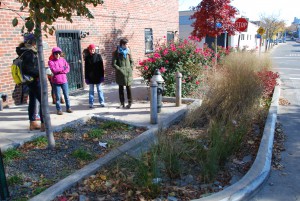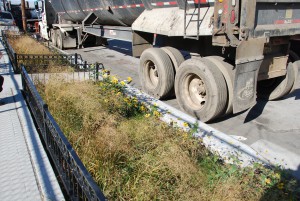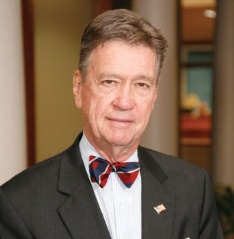New Jersey Future Blog
Case Study: How Bioswales Are Helping To Clean Brooklyn’s Gowanus Canal
April 11th, 2016 by Kevin Burkman

Photo credit: Kevin Burkman
Bioswales have become a key tool in urban green infrastructure. These features, comprising soil, rocks, and living vegetation, are designed to absorb and slow down storm runoff from streets, parking lots, and other impervious surfaces. Generally located at street gutter and drain sites, bioswales also capture silt and pollution from the runoff stream. More importantly, in cities with older sewer infrastructure, bioswales help to reduce the amount of runoff water entering the sewage-treatment system, lowering the risk of raw-sewage overflows into local, fragile waterways. One community that has embraced bioswales in its street infrastructure is the post-industrial neighborhood of Gowanus in Brooklyn, N.Y.
Gowanus became an industrial hub after a canal (previously a creek) was built in the 1860s. Until the 1960s, the area was home to dozens of industries, including tanneries, coaling stations, and paint, ink, and chemical manufacturers. The area has paid a price for its industrial legacy. Over the course of a century, pollution generated by these industries has fouled both the waters of the canal and its sediments. The canal is considered one of the most polluted waterways in the U.S., and in 2010 was designated by the Environmental Protection Agency as a Superfund site.

Photo credit: Kevin Burkman
The environmental damage is not solely from industry; CSOs contribute greatly to the canal’s pollution. The Gowanus sewage system, typical of most industrial era cities, also receives water from pipes that serve as drainage for surface stormwater in streets. During dry weather conditions, raw sewage is conveyed to sewage treatment plants. During periods of intense precipitation and storm runoff, the treatment plant can become overwhelmed and raw sewage is diverted to pipes that discharge into the canal and connected waterways, driving up fecal contamination in the water
In an effort to reduce these overflows, the New York City Department of Environmental Protection is in the process of installing nearly 100 bioswales in the Gowanus Canal watershed. It is estimated that these curbside installations will keep eight million gallons of stormwater runoff out of the city-wide sewer system each year.
A local group that has a particular interest in these bioswales is the Gowanus Canal Conservancy. The group is a community-based non-profit organization that serves as the environmental steward for the Gowanus watershed. The conservancy offers opportunities to become involved with the maintenance and promotion of the watershed’s green infrastructure through their Bioswale Stewardship Program, a volunteer-based initiative where small groups meet from March through June for fieldwork involving bioswales, gardens, and trees within the watershed. The conservancy also offers bioswale maintenance classes, which include 16 hours of free training to learn how bioswales work, and lessons in bioswale plants and weed identification. The conservancy also offers guided walks of the Gowanus watershed, which focus on the environment and redevelopment of the community.
Like New York and other post-industrial regions, New Jersey also has aging storm and sewage systems. There are some 212 CSOs in 21 municipalities across the state. In some of these municipalities, old pipes have begun to crack and collapse (some, constructed in the late 1800s, are made of clay or brick). New CSO permitting standards require operators of combined-sewer treatment plants to develop, adopt and implement a plan to control overflows of raw sewage. Bioswales can help these communities with effective and proven storm run-off control.
In addition to bioswales, other green infrastructure features, such as rain barrels, rain gardens, and tree boxes, are all effective (and relatively low-cost) methods, which municipalities and private individuals can employ to help mitigate the effect of storm run-off into CSOs. For more information, check out New Jersey Future’s Mainstreaming Green Infrastructure project; Jersey Water Works’ resources on green infrastructure; and the NJDEP’s Green Infrastructure in New Jersey and Rutgers University’s Water Resources Program websites.
















